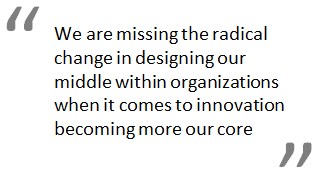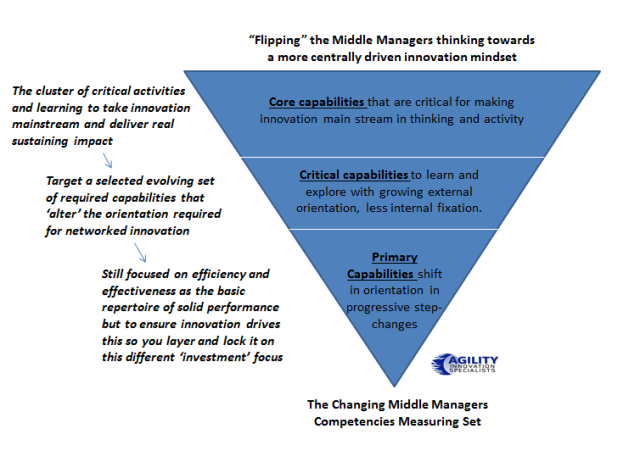
Let’s admit it, our middle management needs a radical makeover, a new fitness regime to make us far more innovation fit.
Most organizations do need to change their middle management structures as they are far from that necessary ‘fitness for 21st-century purpose’ in a constantly changing, challenging, more open innovating world.
The general argument goes and I relate to this, that the middle manager is so pressured to focus on the delivery of short-term results that all their efforts are centred far more on delivering ‘just’ an effective organization.
An organization that focuses on driving out any excess or leeway, reducing the variations, constantly dampening down potential risk and uncertainty.
Today much of this being ‘efficient and effective is in direct conflict with what innovation requires. A space for ‘cutting’ some slack, seeking differences, exploring what variances can provide, and encouraging a certain risk and uncertainty to allow for fresh thinking to emerge that leads to better things within the organization.
Yet the middle manager’s obsession with constantly chasing efficiencies alone, there is little ‘slack’ for innovation and new learning. Their measurement is often based on this efficiency and effectiveness emphasis and not on generating innovation.
Resources are often in conflict when it comes to innovation
Middle managers are being stretched as much or even more than the majority. They fight to keep their people, argue endlessly about what and how they can manage the constant flow of change that is coming from all directions.
They are pressured for time, to think, to fully engage and these mounting pressures are simply squashing out the opportunity to explore, it is actually squeezing the middle managers’ ability to build a more flexible, responsive organization. Innovation is in direct ‘tension’ with much that is being undertaken at the middle management level.

This does result in sacrificing ‘creative time’ by working purposefully toward a well-tuned and efficient operating system, where it seems innovation is not capable to move from a collection of ad hoc activities into one that builds progressively that more sustaining innovation structure, establishing a deepening set of capabilities that this requires.
We are missing the radical change in designing our middle within organizations when it comes to the innovation becoming more our core.
The conflict of sustaining performance and allowing freedom to be creative
Although organizations claim to be innovative, often the very people that we are expecting to manage the ‘dynamics of innovation’ within organizations, the Middle Managers, are seeking the very opposite, doing everything possible to keep the environment as stable and consistent as it can be.
They are taking away the ‘vital essences’ that innovation needs – a fluid, agile, open, diverse and flexible environment and putting consistent constraints and barriers in the way of their pursuit of efficiency and predictable effectiveness. It often can’t be helped; they are expected to keep the system as effective and efficient as possible to sustain performance.
How can we move the needle and tilt it more towards innovation becoming more central without inflicting a more radical overhaul, one that is unlikely to happen in most existing organizations?
Let’s turn the existing core competencies needed for middle managers on their head and offer a new mix of primary, critical and core capabilities that are the measuring point for the MM’s new core competency set that provides for a clearer innovation focus as essential to master.
Let’s flip the thinking and set new requirements
We all recognize that the dedicated middle manager holds the organization together. They are often the glue that connects the organization with the leadership and enable the ‘forces’ to flow, yet do they allow this for innovation?
In traditional Chinese culture qì (also chi or ch’i) is an active principle forming part of any living thing. Qi is frequently translated as “life energy”, “life force”, or the energy flow “and innovation is the same vital need within organizations.
The problem we often have to face today is to resolve that the middle manager is tending to block the creative flows. The layers below and the layers above are disconnected and it is this essential middle that needs to allow this dynamic flow up and down organizations, to allow innovation to become more aligned and consistently being in-tune with its needs, as seen by the top of the organization.
Changing the focus can provide a different mentality and energy force Flipping the thinking on capabilities around for the Middle Manager 
- Primary becomes the base, not the pinnacle. What they do in efficiency and effectiveness remains as their primary capability – you don’t alter this, it is too ingrained. This can only change over time and through their inner awareness and recognition that innovation needs to be embedded, alongside the existing ‘fixation’ on efficiency and effectiveness.
- Don’t try to radically change, make progressive step changes. Efficiency and effectiveness clearly remain the inventory repertoire of solid capabilities so as you set about to build a new platform, based on innovation, it layers and interlocks
- You target selected critical capabilities to learn and explore. You provide the MM with a new clarity of the emerging critical capabilities they need to build up for innovation to become a more sustaining, more in-built core. These are the capabilities that will provide the greatest impact for sustaining competitive advantage, not internal in focus but external in all its orientation to become closer to the real customer’s needs.
- At the top of the pyramid are the core capabilities they need to possess. This cluster of capabilities is centred on the critical capabilities to make innovation main stream, to become a daily part of their thinking, their make-up, and their intent to ensure innovation happens and flows throughout the organization.
- These differ according to the role, area of focus and contribution but are ones connected to innovation – design thinking, networking, motivating creative activity, encouraging experimentation, offering a more safe-to-fail environment, seeking better and more rewarding outputs and outcomes from the activity generated.
The middle manager carries through connection and identification as facilitators
Middle manager’s tasks should increasingly become more about performing the role of connectors and facilitators, not the guardians and gatekeepers for the decision-makers. Their work should include the encouragement that everyone is engaged in innovative work.
Making sure everyone has a ‘sight-line’ and identification into their contribution for any organizational innovation framework so they stay well-connected and engaged. The art of communicating and looking to build new relationships constantly becomes the key.
We need to find that new high ground for middle managers to be seen as the real connectors and enablers and not the current view as more often than not the blockers on innovation in gaining access to the knowledge to help us do a better job.
We all need to think about flipping our thinking of what is needed in the middle of our organizations and it does need to recognize the middle manager’s position, one that is more under threat than ever, needs fresh thinking, it needs new core capabilities.
*****
Publishing note: This blog post was originally written on behalf of Hype and with their permission I have republished it on my own site. I recommend you should visit the Hype blog site where they have a range of contributors writing about a wide-ranging mix of ideas and thoughts around innovation, its well worth the visit.
 Let’s admit it, our middle management needs a radical makeover, a new fitness regime to make us far more innovation fit.
Let’s admit it, our middle management needs a radical makeover, a new fitness regime to make us far more innovation fit.

2 thoughts on “Redesigning the organizations middle for a new innovation shape.”
Comments are closed.